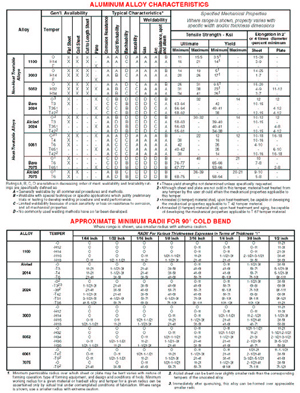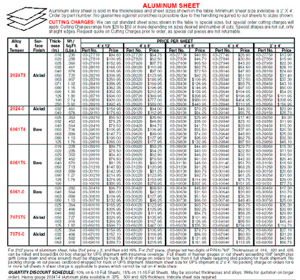1100
This grade is commercially pure aluminum. It is soft and ductile and has
excellent workability. It is ideal for applications involving intricate
forming because it work hardens more slowly than other alloys. It is the
most weldable of aluminum alloys, by any method. It is non heat-treatable.
It has excellent resistance to corrosion and is widely used in the chemical
and food processing industries. It responds well to decorative finishes
which make it suitable for giftware.
2011
This is the most free-machining of the
common aluminum alloys. It also has excellent mechanical properties.
Thus, it is widely used for automatic screw machine products in parts
requiring extensive machining.
2014 & 2017
The 2017 alloy combines excellent
machinability and high strength with the result that it is one of the
most widely used alloys for automatic screw machine work. It is a tough,
ductile alloy suitable for heavy-duty structural parts. Its strength
is slightly less than that of 2014.
2024
This is one of the best known of the high
strength aluminum alloys. With its high strength and excellent fatigue
resistance, it is used to advantage on structures and parts where good
strength-to-weight ratio is desired. It is readily machined to a high
finish. It is readily formed in the annealed condition and may be subsequently
heat treated. Arc or gas welding is generally not recommended, although
this alloy may be spot, seam or flash welded. Since corrosion resistance
is relatively low, 2024 is commonly used with an anodized finish or
in clad form (“Alclad”) with a thin surface layer of high purity aluminum.
Applications: aircraft structural components, aircraft fittings, hardware,
truck wheels and parts for the transportation industry.
3003
This is the most widely used of all aluminum
alloys. It is essentially commercially pure aluminum with the addition
of manganese which increases the strength some 20% over the 1100 grade.
Thus, it has all the excellent characteristics of 1100 with higher strength.
It has excellent corrosion resistance. It has excellent workability
and it may be deep drawn or spun, welded or brazed. It is non heat treatable.
Applications: cooking utensils, decorative trim, awnings, siding, storage
tanks, chemical equipment.
5005
This alloy is generally considered to be
an improved version of 3003. It has the same general mechanical properties
as 3003 but appears to stand up better in actual service. It is readily
workable. It can be deep drawn or spun, welded or brazed. It has excellent
corrosion resistance. It is non heat-treatable. It is well suited for
anodizing and has less tendency to streak or discolor. Applications
same as 3003.
5052
This is the highest strength alloy of the
more common non heat-treatable grades. Fatigue strength is higher than
most aluminum alloys.In addition this grade has particularly good resistance
to marine atmosphere and salt water corrosion. It has excellent workability.
It may be drawn or formed into intricate shapes and its slightly greater
strength in the annealed condition minimizes tearing that occurs in
1100 and 3003. Applications: Used in a wide variety of applications
from aircraft components to home appliances, marine and transportation
industry parts, heavy duty cooking utensils and equipment for bulk processing
of food.
5083 & 5086
For many years there has
been a need for aluminum sheet and plate alloys that would offer, for
high strength welded applications, several distinct benefits over such
alloys as 5052 and 6061. Some of the benefits fabricators have been
seeking are greater design efficiency, better welding characteristics,
good forming properties, excellent resistance to corrosion and the same
economy as in other non heat-treatable alloys. Metallurgical research
has developed 5083 and 5086 as superior weldable alloys which fill these
needs. Both alloys have virtually the same characteristics with 5083
having slightly higher mechanical properties due to the increased manganese
content over 5086. Applications: unfired pressure vessels, missile containers,
heavy-duty truck and trailer assemblies, boat hulls and superstructures.
6061
This is the least expensive and most versatile
of the heat-treatable aluminum alloys. It has most of the good qualities
of aluminum. It offers a range of good mechanical properties and good
corrosion resistance. It can be fabricated by most of the commonly used
techniques. In the annealed condition it has good workability. In the
T4 condition fairly severe forming operations may be accomplished. The
full T6 properties may be obtained by artificial aging. It is welded
by all methods and can be furnace brazed. It is available in the clad
form (“Alclad”) with a thin surface layer of high purity aluminum to
improve both appearance and corrosion resistance. Applications: This
grade is used for a wide variety of products and applications from truck
bodies and frames to screw machine parts and structural components.
6061 is used where appearance and better corrosion resistance with good
strength are required.
6063
This grade is commonly referred to as the
architectural alloy. It was developed as an extrusion alloy with relatively
high tensile properties, excellent finishing characteristics and a high
degree of resistance to corrosion. This alloy is most often found in
various interior and exterior architectural applications, such as windows,
doors, store fronts and assorted trim items. It is the alloy best suited
for anodizing applications - either plain or in a variety of colors.
7075
This is one of the highest strength aluminum
alloys available. Its strength-to weight ratio is excellent and it is
ideally used for highly stressed parts. It may be formed in the annealed
condition and subsequently heat treated. Spot or flash welding can be
used, although arc and gas welding are not recommended. It is available
in the clad (“Alclad”) form to improve the corrosion resistance with
the over-all high strength being only moderately affected. Applications:
Used where highest strength is needed.
ALUMINUM
ALLOY DESIGNATIONS
The aluminum industry uses a four-digit index system
for the designation of its wrought aluminum alloys.
As outlined below, the first digit indicates the alloy
group according to the major alloying elements.
1xxx Series
In this group. minimum aluminum content is 99%. and
there is no major alloying element.
The second digit indicates modifications in impurity
limits. If the second digit is zero, there is no special control on
individual impurities. Digits 1 through 9, which are assigned consecutively
as needed, indicate special control of one or more individual impurities.
The last two digits indicate specific minimum aluminum
content. Although the absolute minimum aluminum content in this group
is 99% the minimum for certain grades is higher than 99%, and the last
two digits represent the hundredths of a per cent over 99.
Thus, 1030 would indicate 99.30% minimum aluminum.
without special control on individual impurities. The designations 1130,
1230, 1330, etc.. indicate the same purity with special control on one
or more impurities. Likewise. 1100 indicates minimum aluminum content
of 99.00% with individual impurity control.
2xxx through 9xxx Series
The major alloying elements are indicated by the first
digit, as follows:
2xxx Copper
3xxx Manganese
4xxx Silicon
5xxx Magnesium
6xxx Magnesium and silicon
7xxx Zinc
8xxx Other element
9xxx Unused series
The second digit indicates alloy modification. If the
second digit is zero. it indicates the original alloy: digits 1 through
9, which are assigned consecutively, indicate alloy modifications. The
last two digits have no special significance, serving only to identify
the different alloys in the group.
Experimental Alloys
Experimental alloys are designated according to the four digit system,
but they are prefixed by the letter X. The prefix is dropped when the
alloy becomes standard. During development, and before they are designated
as experimental, new alloys are identified by serial numbers assigned
by their originators. Use of the serial number is discontinued when
the X number is assigned.
ALUMINUM
TEMPER DESIGNATIONS
Temper designations of wrought aluminum alloys consist
of suffixes to the numeric alloy designations. For example, in 3003-H14,
3003 denotes the alloy and “H14” denotes the temper, or degree of hardness.
The temper designation also reveals the method by which the hardness
was obtained. Temper designations differ between non heat-treatable
alloys and heat-treatable alloys. and their meanings are given below:
Non Heat-Treatable Alloys
The letter “H” is always followed by 2 or 3 digits.
The first digit indicates the particular method used to obtain the temper.
as follows:
— Hl means strain hardened only.
— H2 means strain hardened, then partially annealed.
— H3 means strain hardened, then stabilized.
The temper is indicated by the second digit as follows:
2 1/4 hard
4 I/2 hard
6 3/4 hard
8 full hard
9 extra hard
Added digits indicate modification of standard practice.
Heat-Treatable Alloys
-F As fabricated
-O Annealed
-T Heat treated
The letter “T” is always followed by one or more digits.
These digits indicate the method used to produce the stable tempers,
as follows:
-T3 Solution heat treated, then cold worked.
-T351 Solution heat treated, stress-relieved stretched,
then cold worked.
-T36 Solution heat treated, then cold worked (controlled).
-T4 Solution heat treated, then naturally aged.
-T451 Solution heat treated, then stress relieved
stretched.
-T5 Artificially aged only.
-T6 Solution heat treated, then artificially aged.
-T61 Solution heat treated (boiling water quench),
then artificially aged.
-T651 Solution heat treated, stress-relieved stretched,
then artificially aged (precipitation heat treatment).
-T652 Solution heat treated, stress relieved by compression.
then artificially aged.
-T7 Solution heat treated, then stabilized.
-T8 Solution heat treated, cold worked, then artificially
aged.
-T81 Solution heat treated, cold worked (controlled),
then artificially aged.
-T851 Solution heat treated, cold worked, stress-relieved
stretched, then artificially aged.
-T9 Solution heat treated, artificially aged, then
cold worked.
-T10 Artificially aged, then cold worked.
Added digits indicate modification of standard practice.
COMPARISON
OF MODERN &
OLD SYSTEMS OF ALUMINUM ALLOY DESIGNATION
Although the old system of aluminum identification
has been obsolete for many years, stock with the old markings is still
occasionally found. The following comparison is presented as an aid
in identifying such materials in terms of the modern system.
In the old system, alloy composition was indicated
by a one- or two-digit number followed by the letter “S” to indicate
that it was a wrought alloy, i.e., an alloy that could be shaped by
rolling, drawing or forging. Any variation in the basic composition
was indicated by a letter preceding the numerical alloy designation.
For example, A17S was a modification of the basic alloy 17S. In modern
terminology these two alloys are designated 2117S and 2017S, respectively.
Temper was designated by a second letter: “O” for soft (annealed), “H”for
strain hardness of non heat-treatable alloys, and “T”for hardness of
heat-treatable alloys. Degree of hardness of non heat-treatable alloys
was indicated by a fraction preceding the letter “H”. For example, 3S1/4H
would be quarter-hard 3S alloy.
The following Table gives examples of the old and modern
designations of some common aluminum alloys.
|



 Aircraft Spruce Australia
Aircraft Spruce Australia